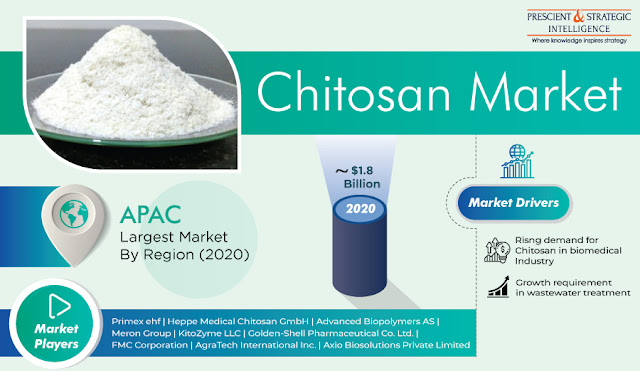
Food and Beverage Companies Using Chitosan as Food Preservative to Reduce Toxicity
Chitosan refers to a semisynthetic material that is obtained through the deacetylation of chitin. It comprises N-acetyl-glucosamine (acetylated monomer) and glucosamine (deacetylated monomer) monomers, which are linked through β-,4 glycosidic bonds. At present, a considerable volume of this material is used as food preservative to extend shelf life of perishable food items, owing to its non-toxic property. Unlike traditional preservatives, such as formalin, chitosan is more biocompatible and does not lead to cancer, lung diseases, and skin disorders.
Thus, the increasing use of chitosan as food preservative will support the chitosan market growth during the forecast period (2021–2030). Moreover, the surging use of this chemical in drug delivery systems, on account of its ability to reduce enzyme degradation, facilitate the uptake of drugs by target tissues or cells, prolong cycle time, and increase water solubility and stability of drugs, will also contribute to the market growth exponentially. According to P&S Intelligence, the market generated $1.8 billion revenue in 2020.
In addition, the biochemical industry also uses chitosan as a vital raw material for bioactive agents, due to its biocompatibility. Biochemical companies use this material to produce bioactive materials like films, sponges, hydrogels, and fibers. Apart from the food and beverage and biochemical industries, a large quantity of chitosan is also used in the cosmetics, agriculture, and water treatment industries. Furthermore, this semisynthetic material is used in the production of protective clothing and fiber reinforcement composites. Moreover, industrial, food, and pharmaceutical grade chitosan used by end users are derived from multiple sources of chitin.
The source segment of the chitosan market is classified into shrimp, lobster, crab, prawn, and others, such as squids, krills, fungi, and centric diatoms. Under this segment, the shrimp category accounted for the largest market share in 2020, and it is also expected to continue witnessing this trend throughout the forecast period. This can be owed to the high content of chitin in shrimp shells and extensive demand for shrimp chitosan from water treatment plants. Additionally, the increasing use of shrimp chitosan as an ingredient in food preservatives will also contribute to the market growth in this category, globally.
Globally, the Asia-Pacific chitosan market generated the highest revenue during the historical period (2015–2020), and it is also expected to exhibit the fastest growth during the forecast period. This can be credited to the surging focus of market players on R&D and the increasing prevalence of chronic diseases in the region. Additionally, the mounting investments being made by private and government organizations of India, China, and Malaysia in the water treatment sector will also steer the demand for chitosan in APAC.
Therefore, the surging need for non-toxic food preservatives and the burgeoning demand for bioactive materials are expected to fuel the consumption of chitosan across the world.
Comments